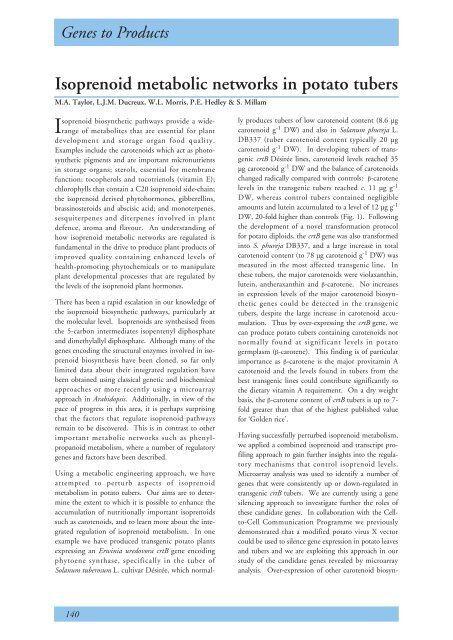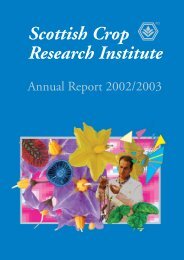SCRI Annual Report 2003/2004 - Scottish Crop Research Institute
SCRI Annual Report 2003/2004 - Scottish Crop Research Institute
SCRI Annual Report 2003/2004 - Scottish Crop Research Institute
Create successful ePaper yourself
Turn your PDF publications into a flip-book with our unique Google optimized e-Paper software.
Genes to Products<br />
Isoprenoid metabolic networks in potato tubers<br />
M.A. Taylor, L.J.M. Ducreux, W.L. Morris, P.E. Hedley & S. Millam<br />
Isoprenoid biosynthetic pathways provide a widerange<br />
of metabolites that are essential for plant<br />
development and storage organ food quality.<br />
Examples include the carotenoids which act as photosynthetic<br />
pigments and are important micronutrients<br />
in storage organs; sterols, essential for membrane<br />
function; tocopherols and tocotrienols (vitamin E);<br />
chlorophylls that contain a C20 isoprenoid side-chain;<br />
the isoprenoid derived phytohormones, gibberellins,<br />
brassinosteroids and abscisic acid; and monoterpenes,<br />
sesquiterpenes and diterpenes involved in plant<br />
defence, aroma and flavour. An understanding of<br />
how isoprenoid metabolic networks are regulated is<br />
fundamental in the drive to produce plant products of<br />
improved quality containing enhanced levels of<br />
health-promoting phytochemicals or to manipulate<br />
plant developmental processes that are regulated by<br />
the levels of the isoprenoid plant hormones.<br />
There has been a rapid escalation in our knowledge of<br />
the isoprenoid biosynthetic pathways, particularly at<br />
the molecular level. Isoprenoids are synthesised from<br />
the 5-carbon intermediates isopentenyl diphosphate<br />
and dimethylallyl diphosphate. Although many of the<br />
genes encoding the structural enzymes involved in isoprenoid<br />
biosynthesis have been cloned, so far only<br />
limited data about their integrated regulation have<br />
been obtained using classical genetic and biochemical<br />
approaches or more recently using a microarray<br />
approach in Arabidopsis. Additionally, in view of the<br />
pace of progress in this area, it is perhaps surprising<br />
that the factors that regulate isoprenoid pathways<br />
remain to be discovered. This is in contrast to other<br />
important metabolic networks such as phenylpropanoid<br />
metabolism, where a number of regulatory<br />
genes and factors have been described.<br />
Using a metabolic engineering approach, we have<br />
attempted to perturb aspects of isoprenoid<br />
metabolism in potato tubers. Our aims are to determine<br />
the extent to which it is possible to enhance the<br />
accumulation of nutritionally important isoprenoids<br />
such as carotenoids, and to learn more about the integrated<br />
regulation of isoprenoid metabolism. In one<br />
example we have produced transgenic potato plants<br />
expressing an Erwinia uredovora crtB gene encoding<br />
phytoene synthase, specifically in the tuber of<br />
Solanum tuberosum L. cultivar Désirée, which normally<br />
produces tubers of low carotenoid content (8.6 µg<br />
carotenoid g -1 DW) and also in Solanum phureja L.<br />
DB337 (tuber carotenoid content typically 20 µg<br />
carotenoid g -1 DW). In developing tubers of transgenic<br />
crtB Désirée lines, carotenoid levels reached 35<br />
µg carotenoid g -1 DW and the balance of carotenoids<br />
changed radically compared with controls: β-carotene<br />
levels in the transgenic tubers reached c. 11 µg g -1<br />
DW, whereas control tubers contained negligible<br />
amounts and lutein accumulated to a level of 12 µg g -1<br />
DW, 20-fold higher than controls (Fig. 1). Following<br />
the development of a novel transformation protocol<br />
for potato diploids, the crtB gene was also transformed<br />
into S. phureja DB337, and a large increase in total<br />
carotenoid content (to 78 µg carotenoid g -1 DW) was<br />
measured in the most affected transgenic line. In<br />
these tubers, the major carotenoids were violaxanthin,<br />
lutein, antheraxanthin and β-carotene. No increases<br />
in expression levels of the major carotenoid biosynthetic<br />
genes could be detected in the transgenic<br />
tubers, despite the large increase in carotenoid accumulation.<br />
Thus by over-expressing the crtB gene, we<br />
can produce potato tubers containing carotenoids not<br />
normally found at significant levels in potato<br />
germplasm (β-carotene). This finding is of particular<br />
importance as β-carotene is the major provitamin A<br />
carotenoid and the levels found in tubers from the<br />
best transgenic lines could contribute significantly to<br />
the dietary vitamin A requirement. On a dry weight<br />
basis, the β-carotene content of crtB tubers is up to 7-<br />
fold greater than that of the highest published value<br />
for ‘Golden rice’.<br />
Having successfully perturbed isoprenoid metabolism,<br />
we applied a combined isoprenoid and transcript profiling<br />
approach to gain further insights into the regulatory<br />
mechanisms that control isoprenoid levels.<br />
Microarray analysis was used to identify a number of<br />
genes that were consistently up or down-regulated in<br />
transgenic crtB tubers. We are currently using a gene<br />
silencing approach to investigate further the roles of<br />
these candidate genes. In collaboration with the Cellto-Cell<br />
Communication Programme we previously<br />
demonstrated that a modified potato virus X vector<br />
could be used to silence gene expression in potato leaves<br />
and tubers and we are exploiting this approach in our<br />
study of the candidate genes revealed by microarray<br />
analysis. Over-expression of other carotenoid biosyn-<br />
140
















